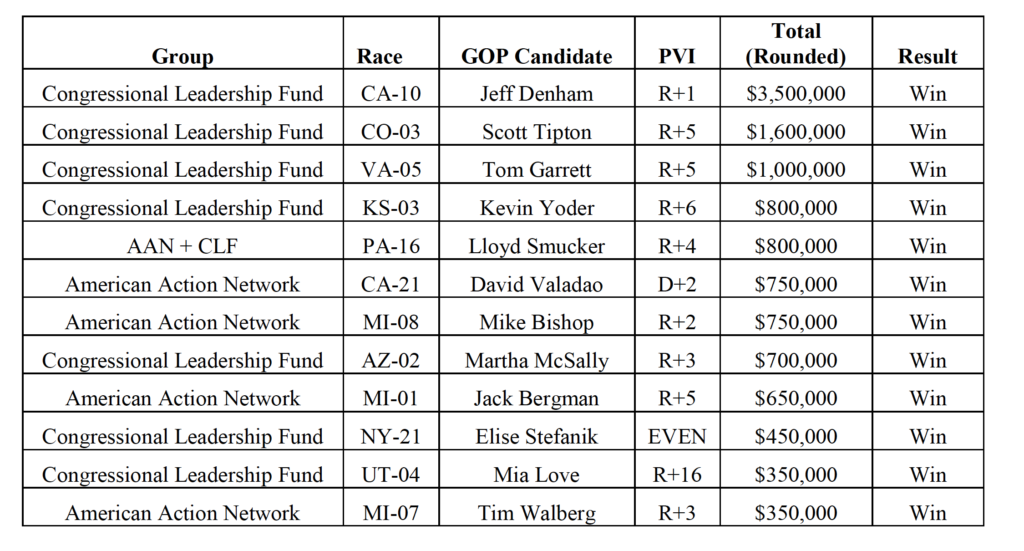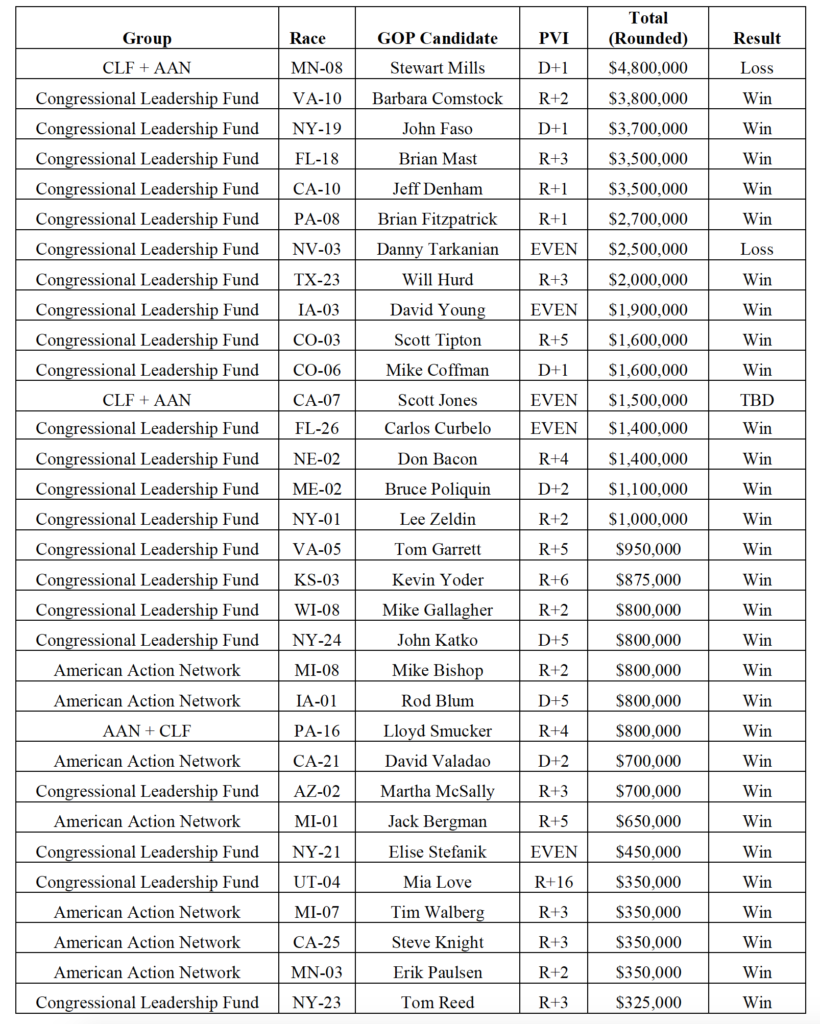Blueprints for Victory
Memorandum
To: Interested Parties
From: Mike Shields, CLF president
Date: November 10, 2016
Re: Outside Spending and the Blueprints for Victory
From the White House to Congress, the Republican electoral triumph is no coincidence. The American people have wholesale rejected the liberal, big government mentality that has ruled Washington for the past eight years. While signs of disruption and political upheaval appeared throughout this election cycle, the scope of Americans’ dissatisfaction defied predictions.
How did House Republicans win?
As the leading conservative outside spenders for the U.S. House, the Congressional Leadership Fund (CLF) along with our sister 501c4, American Action Network (AAN), we are very proud of our role as a catalyst in these races. Together, our organizations spent a record $48 million in 32 congressional seats nationwide – more than twice the amount of any previous election cycle. We invested in data, polling, research, television, radio, digital, mail, phones, and ground game programs. And our return on investment is extraordinary: 29 wins, 2 losses, 1 undecided. All of it done without any significant other outside partners.
Great credit goes to the NRCC for their commanding role in the House race battlefield, including strong candidate recruitment and development, sharp political strategy and map definition. The NRCC put a record $90 million into the field and deployed it in the most effective way possible. Additionally, our Republican candidates worked tirelessly to tell their own stories and run on real policy solutions – all framed with Speaker Paul Ryan’s Better Way policy agenda. And overall, Donald Trump’s electoral victory helped turn out the vote for Republican candidates and fuel congressional wins.
Without question, the challenges Republicans faced this cycle were often daunting and wildly unpredictable. But in the end, the story of how Republicans defended their historically large House majority comes down to resources, infrastructure, strategy and the environment. We utilized the first three elements to capitalize on the fourth, and put House Republicans in a strong position to promote center-right solutions under Speaker Ryan’s leadership and Donald Trump’s presidency.
With the 2016 election in the books, here are five of CLF + AAN’s blueprints for victory:
1. Break Fundraising Records to Build a Commanding War Chest
Thanks to Speaker Paul Ryan’s outstanding House leadership and policy agenda, donors were inspired to support the cause of protecting the House Republican majority. As a result, CLF raised over four times its fundraising total of any previous cycle. CLF entered October with a $33.3 million war chest.
This blockbuster fundraising allowed us to make TV reservations earlier to lock in better rates while at the same time stockpiling resources to ensure CLF could be agile and forceful late in the game. With resources to spend on offense and defense, CLF helped ensure that Speaker Ryan and House Republicans have the strongest Majority possible.
2. Invest Early in Data and Analytics for More Efficient, Effective Advertising
We knew going into this election that the traditional Republican voter models wouldn’t work. Our dollars needed more efficiency and accuracy than ever before to break through the presidential race noise.
CLF made an early decision this cycle to invest in voter data analysis and modeling, partnering with two media optimization firms, 0ptimus and Deep Root Analytics. Using data from the GOP’s top source, the Data Trust, these optimization firms helped identify, model and target specific voter universes we needed to turn out for Republican congressional victories.
As AdAge profiled CLF’s data investment in early September:
Deep Root and 0ptimus employ Rentrak TV viewing data along with other information on voters to help CLF optimize where and how it buys media. The firms help the PAC uncover which TV programs and channels its targeted voters watch in hopes of serving them ads in relevant and often relatively inexpensive ad slots. It’s the modern approach to the more traditional reliance on spray-and-pray style TV buying methods that have resulted in ads being wasted on voters who are not part of the target audience.
The result: our TV buys and online advertising achieved greater precision, resulting in greater return on investment for the tens of millions of dollars CLF spent on House races.
3. Keep Spending on Offense to Gain Seats and Deflect Democrat Dollars
With a historically large majority, House Republicans had already won nearly every competitive seat on the map. Yet for the few GOP pick up opportunities this election, CLF invested heavily to play offense.
CLF spent a combined $4.7 million to flip two Democrat-held seats: Florida’s 18th congressional district and Nebraska’s 2nd congressional district. And we couldn’t be more proud of helping elect two great veterans: Army combat veteran Brian Mast (FL-18) and retired Brigadier General Don Bacon (NE-02). National Democrats sunk over $3.5 million into trying to hold these seats in what was supposed to be their offensive year.
And CLF + AAN spent another $6 million on offense in two more seats: California’s 7th congressional district, which is currently too close to call, and Minnesota’s 8th congressional district, a loss by less than one percent. With our firepower trained on MN-08, Democrats were forced to spend millions of dollars defending Rick Nolan. As a result, Democrats were left with fewer resources for the other two competitive seats they were targeting in the Minneapolis-St Paul media market: MN-02, won by Republican Jason Lewis, and MN-03, won by Republican Erik Paulsen.
4. Deploy a Firewall Strategy as an Insurance Policy
The volatility and uncertainty of this election cycle required decisive action to ensure a protected map. As media storms rolled and the congressional generic ballot began to slide in early October, we deployed a firewall strategy to build a protective shield around Tier 2 races. Thanks to our record war chest, we were able to buy up Tier 2 markets – depriving Democrats of the ability to expand the map and pushing the fight back into Tier 1 seats.
POLITICO called our firewall strategy deployment one of the defining moments of the 2016 election:
When things started to look bad for the congressional GOP in early October, House Republicans’ biggest super PAC was there to fight the fire. Congressional Leadership Fund and its sister nonprofit, American Action Network, dumped $10 million into races where Democrats could have expanded the map right after the Access Hollywood tape broke, giving cover and a financial advantage to some Republican incumbents worried the national tide was about to turn against them.
Ultimately, our firewall strategy helped ensure Republican victories in a dozen districts. This strategy proved crucial in districts that became more competitive and in districts where Democrats were deterred from spending. Additionally, we helped Republican candidates run up the score in key districts, hindering Democrats’ ability to compete there in the future.
Here are the districts where we built the firewall:
5. Capitalize on Democrats’ Colossal Mistakes: One-Size-Fits-All Trump Strategy & ImWithHer
Democrats committed political malpractice in this election. First, national Democrats employed a cookie-cutter campaign of trying to use Donald Trump as a cudgel on Republicans in races nationwide. This was an expensive and catastrophic mistake. Democrats ran over 140 ads in 30 districts using Trump against Republican Members. Democrats’ one-size-fits-all strategy ignored the great divides of this election: insider v. outsider, college educated v non-college educated, rural v suburban/urban, and the seismic shift of white working class voters. Their playbook only contained one play, and it didn’t work.
Second, Democrats never came to terms with the toxicity of Hillary Clinton. Democrats said “I’m With Her” to a dishonest and untrustworthy candidate who is the epitome of the insider Democrat establishment.
Voters’ willingness to confront Hillary surfaced in every district CLF polled. In 40 congressional districts, CLF asked the hypothetical question: “Would you rather have a Republican Member of Congress who will fight Hillary Clinton as president or a Democrat who will help her?” The average results: fighting Hillary won 50% to 37%. This polling was a window into the undercurrent of disapproval and ultimately rejection of Hillary Clinton this election.
Our Return on Investment
CLF + AAN spent over $48 million in 32 races. Our remarkable results speak for themselves: 29 wins, 2 losses and 1 undecided. Our gratitude for Speaker Ryan’s House leadership and conservative vision, donors’ contributions and the hard work of CLF’s team that helped make these victories possible.


